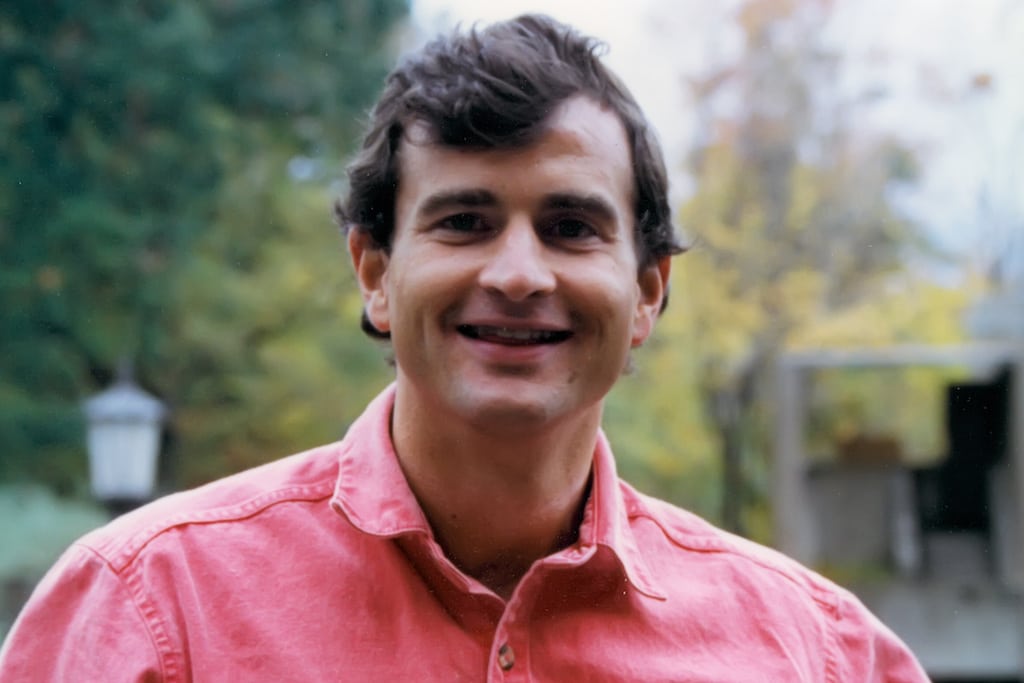Skift Take
We don't know if it was really "a supermodel" and her tiny dog that William Shatner dispatched to Priceline.com headquarters in the late 1990s to do due dilgence on the company, but we do know that Shatner, who smashed a guitar during one shoot, was highly talented and broke new ground for an emerging brand.
 Skift launched its largest and most ambitious project yet, The Definitive Oral History of Online Travel, on June 1.
Skift launched its largest and most ambitious project yet, The Definitive Oral History of Online Travel, on June 1.
In nearly 40,000 words founders, CEOs, other executives and insiders tell a story in their own words about the creation of Internet giants such as Expedia, Priceline, Travelocity, Orbitz, TripAdvisor and more.
Not all of the interviews fit into the big story so we are publishing standalone stories that offer deeper insight into information we collected during the three-month research process.
After his roles as Captain Kirk in Star Trek in the 1960s and T.J. Hooker in the 1980s, actor William Shatner’s career was seemingly in its latter stages in 1998 when a Priceline.com marketing executive, Jord Poster, figured out a way to contact him through a personal connection, and helped create the magic that became Shatner as the legendary spokesman of Priceline.
Skipping the go-betweens, Poster arranged a meeting between Shatner and Priceline.com founder and then-CEO Jay Walker. Shatner signed on to do radio for Priceline and then about a year later, in 1999, Walker recalls, Shatner sent a representative in a limousine to Priceline.com headquarters in Norwalk, Connecticut, to perform due diligence on the idea of doing TV for the online travel agency.
In this article today, and one to follow tomorrow, we’ll highlight the roles of three executives whose names aren’t widely known and who are no longer living. Nevertheless, they played important roles in the evolution of online travel.
Today we’re focusing on Jord Poster, a former Priceline.com marketing executive, who died of cancer in 2012. Poster was instrumental in working with Shatner, convincing him to do TV for Priceline.com, and taking branding to new levels through TV advertising.
Jay Walker: I got your note that you were calling me about Jord Poster.
Skift: That’s it, exactly.
Walker: What an amazing guy.
Skift: Yeah, why? Tell me why. Tell me about him.
Walker: Jord Poster is the guy who made William Shatner possible at Priceline. Without Jord Poster, there would have been no William Shatner at Priceline, and without William Shatner at Priceline, I think it would have been quite awhile before anybody created a celebrity superstar brand effort. Because Jord was a brand guy. In those days of the Internet, there was nobody who hired celebrity brands, and there was nobody who did advertising on radio and television for Internet brands, for e-commerce brands. There was nobody doing that.

A marketing executive during the founding of Priceline.com, Jord Poster convinced William Shatner to try TV advertising for the company. Photo from Jay Walker.
Jord was ultimately the guy who persuaded Bill to do this and ultimately persuaded Bill to continue to do it when he moved from radio to television, which Bill was very reluctant to do. He was on his horse on his farm, and Jord went down to the farm [in 1999]. He literally had to get Bill Shatner off the horse because he was pretty much retired and done. His career was pretty much finished at the time. So Bill Shatner’s whole second career is because of Jord Poster.
What was interesting is there were two guys at Priceline. Jord Poster was the brand guy. He was all things brand. In fact, he’s the reason not only that we hired Shatner; he’s the reason we hired Hill Holiday, which was the agency that took Shatner, and we were catapulted. Hill Holiday was a phenomenal creative agency. Paul Breitenbach (CMO of Priceline.com 1996-2000) was the direct marketing guy, the real day-in, day-out, build the business, drive the direct response guy. So I had this team, and they never got along.
On one side is this brand guy who wants big branding efforts and wants to run full page newspaper ads where you barely even mention the name of the company; big pictures of Shatner. There’s this whole idea that this is a cool and you actually can buy things on the Internet. That was one of the big, funny Shatner stories.
On the other side, you’ve got Paul Breitenbach, who was the consummate direct marketer, who figured out how to get radio space for pennies on the dollar and newspaper remnant space for pennies on the dollar by persuading newspapers and radio stations that we were a telemarketing company because we had an 800 number. We bought it as a direct marketing. We were in the Wall Street Journal, the New York Times, and we were the largest radio advertiser in Amercica for two straight years on our launch because Breitenbach persuaded the radio and newspaper guys that we were a direct response advertiser, and direct response advertisers get completely different rates. They had no idea what an Internet company was so Breitenbach persuaded them we were a direct response advertiser.
Poster, on the other hand, wanted nothing to do with direct response. He was a brand marketer. His ex-wife was a college roommate of Shatner’s late wife.
Skift: This is Jord’s ex-wife?
Walker: Jord’s ex-wife. Jord’s not alive, but his ex-wife at the time. He’s been divorced. His ex-wife at the time was the college roommate of Shatner’s wife, Shatner’s second wife, I think. It was the only way we could bypass the agents, because when we went to try and get Bill Cosby, who was our first choice. Cosby’s agents wouldn’t let us anywhere near Cosby, and they wanted a fortune.
We said, ‘This isn’t going to work here.’ Our choices were Shatner and James Earl Jones because we wanted great radio voices. Literally, Poster said, ‘Hey, my wife went to school with Shatner’s wife, we can reach out through Shatner’s wife, and we’ll get you a meeting, Jay, with Shatner. We won’t tell him what it’s about. We’ll just get you to meet with Shatner and tell him that you’re working on some interesting business thing.’
When I met with Shatner and laid out the business, Shatner had no idea you could do commerce on the Internet. He wasn’t an Internet user, not whatsoever, and he had no idea you could buy things on the Internet. ‘You can buy things on the Internet?’ He goes, ‘Well, Jay, are people really going to buy travel, airline tickets, on the Internet?’ I said, ‘Yes, Bill, they really are going to do it.’ It’s a very funny story. Shatner says, ‘OK, I’m going to have my people do some diligence on this if that’s OK with you, Jay.’ I said, ‘Actually, Jord will handle it.’
The day that Shatner’s due diligence people were supposed to show up at Priceline, we had everything ready. We had the data center all cleaned up. We thought they were coming to do a technology due diligence at Priceline and Jord was all ready. Jord handled it all. This giant stretch limousine pulls up, and the guy opens the door, and a little dog gets handed out of the stretch limousine. This little lap dog. Jord was right there getting ready to say hello to whomever. Jord takes the lapdog, and then this woman’s leg comes out of the limousine, and this incredibly tall, beautiful bombshell steps out of the limousine. No Shatner, just her.
And she says, ‘Bill Shatner has sent me here to do diligence on what you guys are doing.’ And Jord, without missing a beat, goes, ‘Absolutely, we’re happy to have you here.’ Jord takes her by the arm and walks her into the offices, walks right past the data center, pays no attention to the data center, sits her down in a conference room, orders all kinds of food and drink, which he had setup, and then just proceeds to gently tell her stories about the people — nothing to do with the business whatsoever — the people and what’s going on in the world, and advertising agencies, and how this would be Bill Shatner coming back, and all kinds of ways to be recognized. It was never about the business.
About an hour-and-a-half later, she was completely done. Jord held out his arm. They went out arm and arm back to the limousine, and getting into the car, she said, ‘I will tell Bill everything here is just as I expected.’
Skift: Who was she?
Walker: I have no idea, no idea. Only Jord would know who she was, and he’s not alive. Literally, Bill Shatner sent a supermodel to do diligence on the business.
Read the Definitive Oral History of Online Travel
Read More
- The Definitive Oral History of Online Travel
- Launching Skift’s Biggest Project Yet: The Definitive Oral History of Online Travel
- The Never-Before-Disclosed Details About the Birth of Online Travel
- Skift Podcast: The Invention of Online Travel and How It Changed the Future of Travel Forever
- Oral History of Online Travel: Barry Diller’s Deals Built Travel Empire
- Oral History of Online Travel: Booking.com Succeeds Despite Doing It ‘Wrong’
- Oral History of Online Travel: Ctrip’s Different Path to China’s Consumers
- Oral History of Online Travel: How Hostelworld Backpacked Its Way to Success
- Oral History of Online Travel: How Travelstart Taught South Africa’s Airlines About E-Commerce
- Oral History of Online Travel: How Decolar Built an Online Booking Brand Offline
Skift: Can you tell me whether Jord was with you at Priceline.com right from the beginning, and what was his title, do you remember?
Walker: It was probably vice president of marketing, would be my guess. We might have given him vice president of brand marketing. He had founder’s shares with us as well. He was a founder.
Skift: Where was he before Priceline?
Walker: He sold his ad agency in Boston to join Priceline because I persuaded him that joining Priceline would be better than running an ad agency. In this whole idea of a TV campaign, Jord basically said, ‘Listen, I can manage Shatner. Even though our contract only covers Shatner on the radio, I can persuade Shatner to do television.’ Jord basically persuaded Shatner to do television for very little money because he convinced Shatner that this would be good for the Shatner brand, and by the way, it was great for the Shatner brand. We were going to do a series of commercials that were going to be completely out there. Remember those Firebird commercials and all that? Jord comes up with this idea of having Shatner reprise his album and playing the guitar and being completely wacko. That was Jord’s recognition that the celebrity of the thing and the self-mockery of the thing was more exciting than selling the idea of the business.
Skift: Why was Shatner initially reluctant to do TV?
Walker: Shatner’s thing was, ‘Guys, people watching television aren’t going to be buying on the Internet. They’re not going to be buying on the Internet.’ In fact, Shatner, at one point during one of the meetings — I remember hearing about it because I wasn’t there — Shatner was on the set with Jord, and they’re filming. This guy has this guitar, and they’re sort of playing this Firebird imitation thing with Shatner’s album. At one point, Shatner sort of gets crazy, and he rips the guitar away from the guy who’s playing it, and he smashes it like one of those rock stars on the ground, just smashes it on the set. Then he turns on the camera because they didn’t even have a line yet, he turns to the camera and says, ‘If saving money is wrong, I don’t want to be right.’ It was just complete genius, right? That’s what Shatner says. And Jord has the presence of mind to say, ‘Perfect, we’ll take it.’ The whole campaign was built around that.
It was just completely outrageous. It was like the inmates running the asylum. They were creating these ads that had nothing to do with airline tickets. It just had everything to do with the celebrity culture of television and how to create a brand that was different, exciting, and stood out to the point where the brand became what it is today, a real, locally known brand. It’s Jord Poster who did it, whereas Breitenbach is the guy who drove the sales. Breitenbach was the guy who converted that brand into real money.
Skift: How long did Jord stay with the company, and when did he die? What happened?
Walker: Jord got cancer. He stayed with the company over five years. At a certain point, the company got so big, we had to say, ‘Jord, look, you’re actually going to have to move to be here or not,’ and he said he didn’t want to move from Boston. He had made a fair amount of money with his founder’s stock, so he did very nicely. He died about four years ago of lung cancer. He was actually an athlete, a runner, and he got lung cancer.
Skift: Terrible.
Walker: It was very sad. Jord is some of the genius behind Shatner and all the brand building, and Breitenbach is the genius behind radio and newspaper and direct-response advertising, allowing us to do extraordinary amounts of advertising very efficiently, which then turned out to be how we drove in the revenue. Brand advertising is great, but it ultimately doesn’t ring the cash register until you drive business. Breitenbach drove the business. He was with the company for many years.
The Daily Newsletter
Our daily coverage of the global travel industry. Written by editors and analysts from across Skift’s brands.
Have a confidential tip for Skift? Get in touch
Tags: advertising, marketing, oral history, ota history, shatner, tv
Photo credit: William Shatner and Kelly Cuoco in an advertising campaign from 2013. Priceline / Reuters
